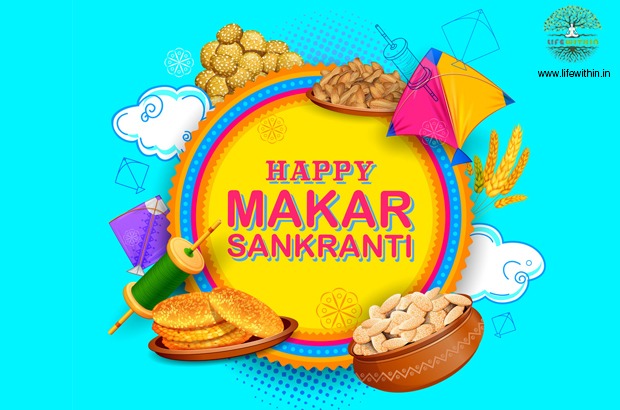Sacred gifts of wealth and greater purpose on Akshaya Tritiya | Preethaji & Krishnaji
- Jan 13, 2021
- 805 View
Makar Sankranti - a day to invite goodness and light in life | Dr. Surendra Kapoor
- Jan 13, 2021
- 1230 View
Makar Sankranti is celebrated in different names and by following different rituals across the country. It is also one o...

Makar Sankranti - a day to invite goodness and light in life
The 11th lunar month and
10th solar month in the Hindu calendar (Vikram samvat) is known by
the name of ‘Maghaa’. One of the reasons why this month is known as magh is
that purnima in collaboration with maghaa nakshatra falls in this month. When
the sun makes a transition from Dhanur Rashi to Makar rashi, it is known as
‘Makar-Sankranti’.
The auspicious Uttarayan period
From the commencement of this day,
the sun turns uttarayan or sets in the northern path; according to Indian shastras,
the period of uttarayan is considered as day while the period of dakshinayan is
considered as night for the gods. Thus, Makar Sankranti can be regarded as the
beginning of day time for the divine powers. Makar Sankranti marks the
beginning of a favourable phase when all kinds of auspicious ceremonies and
sacred rituals can be performed by the people. This day brings an end to the
inauspicious period which had begun around mid-December. Interestingly, the sun
during the uttarayan period is known as ‘Mitra’ or friend as its rays help us
to attain good health, positivity and strength. Hence, Sun God is also shown
reverence on this day. On a spiritual level, Makar Sankranti signifies
enlightenment, happiness, peace and prosperity after a gap of darkness and
ignorance. It is a ‘swyam siddha muhurta’ in which all kinds of auspicious
ceremonies and rituals are sanctified. This year, Makar Sankranti falls on 14th
January.
Rituals followed on this day
On this day, bathing in holy waters,
doing charity, chanting the Holy name of god, meditation and religious
ceremonies have a great importance. It is a common belief that all the gods and
goddesses change their forms and visit Prayag which is the confluence of Ganga,
Yamuna and Saraswati to take bath. Therefore, a sacred dip in Prayag is
undoubtedly the most auspicious one to purify oneself and acquire ‘Punya’. As per the Hindu scriptures, it is said that
any kind of charity done on this day is received back later by a hundredfold.
Making donations of butter, cereals, blanket has a special significance on this
day. One who donates these things is believed to attain moksha or liberation
after enjoying all the pleasures of life. On the day of Makar Sankranti,
bathing in the sacred river of Ganga and doing all kinds of charity work on the
banks of Ganga is regarded highly auspicious.
A special occasion for everyone
Makar Sankranti is celebrated in
different names and by following different rituals across the country. It is
also one of the most important harvest festivals celebrated in many parts of
India. In Gujarat, this festive day turns into a kite flying occasion. As the
kites soar high, the winter sky is blanketed with a colourful hue. Makar
Sankranti is named as ‘Khichdi’ in Bihar, Jharkhand and Uttar Pradesh. This is
why it is a ritual to eat khichdi and donate khichdi-til (sesame seeds) in
Uttar Pradesh, Bihar and Jharkhand. In Maharashtra, married women donate oil,
cotton, salt etc. to other women. In West Bengal, people follow the ritual of
donating sesame seeds after bathing. In Southern India, this holy occasion is
known as Pongal. People offer freshly harvested rice grains, lentils and sesame
seeds to ‘Krishi God’ and express their reverence and gratitude towards the
Almighty. Bhogali or Magh . also Sri Tushoo Puja is done in Assam and hills. In
Assam, the festival of Bihu is celebrated on this day. As per the rituals in
Rajasthan, a married woman offers a variety of sweets such as sesame laddoos,
ghevar and motichur laddoos along with coins to her mother-in-law and seeks her
blessings. In Punjab and Jammu Kashmir, Makar Sankranti is celebrated by the
name of Lohri.
During Makar Sankranti, many kinds of
fairs are organized in the entire country as a part of celebration and fun. One
of the most popular fairs of India is held in Ganga Sagar, West Bengal. In
Prayag, Allahabad, people enjoy and participate in a month-long ‘Magh’ mela or
fair. This year first ‘Sahi Snan’ of Magh mela and ‘Punya Snan’ will be on 14th
January 2021. Other important dates are as under-
Paush Shukla Ekadashi – 24-01-2021
Paush Poornima 28-01-2021
Magh Krishna Chaturthi 01-02-2021
Magh Krishna Ekadashi 07-02-2021
Mauni Amavashya 11-02-2021
Kumbha Sankranti 12-02-2021 and 13-02-2021
Magh Shukla Panchami 16-02-2021
Magh Shukla Saptami 19-02-2021
Maghee Poornima 27-02-2021
Maha Shivratri 11-03-2021
Magh Mela will be celebrated till 27th
February 2021.
Though Makar Sankranti is celebrated
in different parts of the country by observing different kinds of rituals, the
spiritual, religious and social significance of this holy day remains the same
everywhere.
___________________________
By: Dr. Surendra Kapoor
Surendra Kapoor, is a leading light
in the field of Vedic Jyotish, Vastu Shastra, Aura Reading, Naming Names, and
Dream Interpretation. He is a voracious reader, multi-linguistic and
multitalented counsellor. He has been received several prestigious awards.

